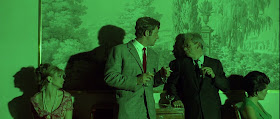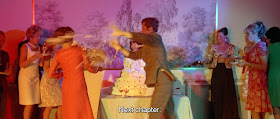Pierrot Le Fou (1965)
Classic Movies
5/5
Image Source: http://www.janusfilms.com/pierrot/pierrotlefouposter.jpg
Some film enthusiasts point out that
Jean Luc-Godard is what Pablo Picasso is to fine art and that “Pierrot Le Fou”
is his cinematic cubism. If you are
familiar with “Bonnie and Clyde” but haven’t seen this French New Wave classic,
you might be missing out on an even better hit-and-run movie about two
criminals that fall in love on their way through the French countryside to the
Mediterranean
Godard’s work helped challenge conventional
cinema to help show that the possibilities in the filmic language are limitless. Like
many other French films in the 60’s, “Pierrot Le Fou” served as influential
ground work for the modern film. The powerful jump cuts, colored filters, and
non-linear structure challenged auteurs to analyze and critique them for their
own personal growth as filmmakers. We see many American films following Godard’s
in the 60’s like “Bonnie and Clyde” and “The Graduate” that are strikingly
informed by the French New Wave style. “Pierrot Le Fou”, in particular, is a summation of the French New Wave’s ideas,
combining many of the themes we’ve seen in Godard’s past explorations: The
feeling of contempt in “Contempt”, women’s desires in ”A Woman is a Woman”, and
the sight that signifies identity and true love in “Breathless”.
Throughout Godard’s
work, we see him explore the oppressive lifestyle of his partner. Watching
this close-up shot on Marianne Renoir (Anna Karina) holding a pair of
scissors in front of the camera lens suggests of her fearlessness and strength.
Similar to “Contempt”, “Pierrot Le
Fou” is one of Godard’s few Technicolor masterpieces of the 60’s. As a general
rule, color serves as an extra layer to the visual arts, but it
particularly helps Godard’s abstract, filmic language which is already
difficult to analyze without it. This is why I believe his best work is in Technicolor; “Breathless”, is a
black-and-white film that many consider to be Godard’s masterwork but I would
argue that the black-and-white effect mostly restricts what Godard is truly
capable of capturing on the screen given the pictorial extremes he reached for
in “Contempt” and “Pierrot Le Fou”. Such convoluted and abstract storytelling
in “Pierrot Le Fou” calls for thought-provoking visuals that challenge the
narrative itself.
One example of this challenge is a scene that he has Ferdinand Griffon (Jean‑Paul Belmondo) attending a party and the shots change colors every
cut. Each color corresponds to the mood of Griffon’s conversations. Green is a color that symbolizes work, career, materialism, and money. Red is a color that symbolizes, re-birth, transformation, hatred and death, Blue is a color that symbolizes dreams, imagination, loneliness and sadness.
At the end
of the scene, Griffon throws a piece of cake and the shot cuts to fireworks. He mentions "despair" and he associates Marianne Renoir with the word, foreshadowing the dark secret she reveals to him at the end of the movie. Pierrot Le Fou” is a visually stunning
achievement that is often over-shadowed by the success of “Breathless” and “Contempt”.
I do believe, however, that Godard is much more dynamic in color than he is
in composition, and it is for this reason that “Pierrot Le Fou” and “Contempt”
are my two personal favorites.
Favorite Reference in Pop Culture
Image Source: http://i.ytimg.com/vi/1sBpz-32zEk/hqdefault.jpg
In Cowboy Bebop, there is an episode titled "Pierrot Le Fou" about a deadly robot whose name is also the title of the film. The episode shows off some of the best animation sequences in the series with its integration of CG and traditional animation. As with other 'Bebop' episodes, the robot doesn't draw any further reference to the film. The name is mostly used to strengthen the thematic nomenclature of the show.








No comments:
Post a Comment